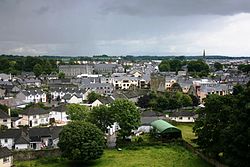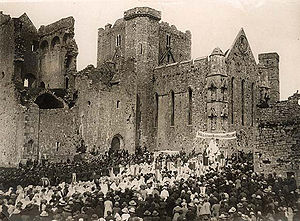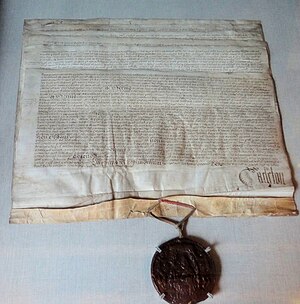Cashel, County Tipperary
| Cashel Irish: Caiseal | |
| County Tipperary | |
|---|---|
 Panorama of town from the Rock of Cashel | |
| Location | |
| Grid reference: | S075408 |
| Location: | 52°31’0"N, 7°53’22"W |
| Data | |
| Population: | 4,051 (2006[1]) |
| Post town: | Cashel |
| Postcode: | E25 |
| Local Government | |
| Council: | Cashel–Tipperary MD |
| Dáil constituency: |
Tipperary |
| Website: | http://www.cashel.ie |
Cashel is a town in the South Riding of County Tipperary. Its population, including environs, was 4,051 at the 2006 census.[1] The town gives its name to the ecclesiastical province of Cashel. Additionally, the cathedra of the Roman Catholic Archdiocese of Cashel and Emly was originally in the town prior to the Reformation. It is part of the parish of Cashel and Rosegreen in the same archdiocese.[2] One of the six cathedrals of the Anglican Bishop of Cashel and Ossory, who currently resides in Kilkenny, is located in the town. It is in the civil parish of St Patricksrock[3] which is in the barony of Middle Third.
Contents
Location and access
The town is situated in the Golden Vale, an area of rolling pastureland in the province of Munster.
Roads
It is located off the M8 Dublin to Cork motorway. Prior to the construction of the motorway by-pass (in 2004), the town was noted as a bottleneck on the N8 Dublin to Cork route.
Bus services
Express bus services are provided between Dublin and Cork which call at Cashel. Buses also link the town to Portlaoise via Urlingford and Thurles to Clonmel via Cashel.
Rail services
The nearest rail station is Cahir railway station, ten miles distant. This station is particularly useful if travelling east to/from Waterford. However the most practical rail station for Cashel is at Thurles railway station as this is on the Dublin-Cork InterCity rail line.
Airports
The nearest airports are Cork Airport and Shannon Airport, both of which are around 50 miles away.
History
Ancient history
The Rock of Cashel, to which the town below owes its origin, is an isolated elevation of stratified limestone, rising abruptly from a broad and fertile plain called the Golden Vale. The top of this eminence is crowned by a group of remarkable ruins. Originally known as Fairy Hill, or Sid-Druim, the Rock was, in pagan times, the dun, or castle, of the ancient Eoghnacht Chiefs of Munster. In Gaelic, Caiseal denotes a circular stone fort and is the name of several places in Ireland. The "Book of Rights" suggests the name is derived from Cais-il, i.e. "tribute stone", because the Munster tribes paid tribute on the Rock. Here Corc, grandfather of Aengus Mac Natfraich, erected a fort. Cashel subsequently became the capital of Munster and, like Tara and Armagh, it was a celebrated court. At the time of St Patrick, when Aengus ruled as king, Cashel claimed supremacy over all the royal duns of the province.
In the 5th century, the Eóganachta dynasty founded their capital on and around the rock. Many kings of Munster have reigned here since. Saint Patrick]is believed to have baptised Cashel's third king, Aengus. In 977 the Dál gCais usurper, Brian Boru, was crowned here as the first non-Eóghanacht king of Cashel and Munster in over five hundred years. In 1101 his great-grandson, King Muirchertach Ua Briain, gave the place to the bishop of Limerick, thus denying it forever to the MacCarthys, the senior branch of the Eóganachta. The bishops had a famous school in Cashel and sent priests all over the continent, especially to Regensburg in Germany, where they maintained their own monastery, called Scots Monastery.
Today the ancient metropolis of Cashel has lost its importance, and its population has fallen to just over 4,000, its highest population in 270 years.
Lordship of Ireland
The Synod of Cashel of 1172 was organised by King Henry II. The Synod sought to regulate some affairs of the Church in Ireland and to condemn some abuses, bringing the Church more into alignment with the Roman Rite. It has been suggested that the seventh act of the Synod called upon the clergy and people of Ireland to acknowledge Henry II as their king.[4] However, a careful reading of the seventh act would not support this interpretation.[5] Nevertheless, there is little doubt that the King's purpose in requiring the convocation was to overawe the Irish clergy with a display of his power; no doubt he succeeded in this. In this scenario, the convocation would be viewed as a pretext for the show of strength.
In 1647, during the Irish Confederate Wars, the town was stormed and sacked by English Parliamentarian troops under The 6th Baron Inchiquin (later created The 1st Earl of Inchiquin). Over 1,000 Irish Catholic soldiers and civilians, including several prominent clerics, were killed in the attack and ensuing massacre.
Ecclesiastical history
About 450, Saint Patrick preached at the royal dun and converted king Aengus. The Tripartite Life of the saint relates that while "he was baptising Aengus the spike of the crozier went through the foot of the King" who bore with the painful wound in the belief "that it was a rite of the Faith". According to the same authority, twenty-seven kings of the race of Aengus and his brother Aillil ruled in Cashel until 897, when Cerm-gecan was slain in battle. There is no evidence that St Patrick founded a church at Cashel, or appointed a Bishop of Cashel. St Ailbe, it is supposed, had already fixed his see at Emly, not far off, and within the king's dominions. Cashel continued to be the chief residence of the Kings of Munster until 1100, hence its title, "City of the Kings". Before that date, there was no mention in the native annals of any Bishop, or Archbishop of Cashel. Cormac MacCullinan is referred to, but not correctly, as Archbishop of Cashel, by later writers. He was a bishop, but not of Cashel, where he was king. The most famous man in Ireland of his time, but more of a scholar and warrior than an ecclesiastic, Cormac has left us a glossary of Irish names, which displays his knowledge of Latin, Greek, and Hebrew, and the "Psalter of Cashel", a work treating of the history and antiquities of Ireland. He was slain in 903, in a great battle near Carlow.
Brian Boru fortified Cashel in 990. Murtagh O'Brien, King of Cashel, in presence of the chiefs and clergy, made a grant in 1101 of the "Rock" with the territory around it to O'Dunan, "noble bishop and chief senior of Munster", and dedicated it to God and St Patrick. Then Cashel became an archiepiscopal see, and O'Dunan its first prelate as far as the primate, S. Celsus, could appoint him. At the synod of Kells, 1152, Cardinal Paparo gave a pallium to Donat O'Lonergan of Cashel, and since then his successors have ruled the ecclesiastical province of Munster. In 1127 Cormac III of Munster, King of Desmond, erected close to his palace on the "Rock" a church, now known as Cormac's Chapel, which was consecrated in 1134, when a synod was held within its walls. During the episcopate of Donal O'Hullican (1158–1182), the King of Limerick, Domnall O'Brien, built in 1169 a more spacious church beside Cormac's Chapel, which then became a chapterhouse.
Maurice, a Geraldine, filled the see from 1504 to 1523, and was succeeded by Edmund Butler, prior of Athassal Abbey, who was a natural son of Pierce, Earl of Ormond. In addition to the wars between the Irish and the English there arose a new element of discord, the Anglican Reformation introduced by Henry VIII. While residing at Kilmeaden Castle Archbishop Butler levied black-mail on the traders of the Suir, robbing their boats and holding their persons for ransom. At a session of the royal privy council held at Clonmel in 1539, he swore to uphold the spiritual supremacy of the king and denied the power in Ireland of the Bishop of Rome. He died 1550 and was buried in the cathedral.
Roland, a Geraldine (1553–1561), was created archbishop by the Roman Catholic Queen Mary. After a vacancy of six years Maurice FitzGibbon (1567–1578) a Cistercian abbot was promoted to the archbishopric by pope Pius V, but James McCawell was put forward by Elizabeth I. Thus began the Anglican religion at Cashel. FitzGibbon, who belonged to the royal Desmond family, being deprived of his see, fled to France and passed into Spain where he resided for a time at the Court. He conferred with the English ambassador at Paris to obtain pardon for leaving the country without the Queen's sanction, and to get permission to return. In this he failed, and going back to Ireland secretly he was arrested and imprisoned at Cork, where he died in 1578. On the death of MacCaghwell, Elizabeth advanced Miler MacGrath, a Franciscan and Bishop of Down, to the See of Cashel. He held at the same time four bishoprics and several benefices, out of which he provided for his numerous offspring. Having occupied the see for fifty-two years, he died in 1622. His monument in the ruined cathedral bears an epitaph written by himself.
Dermot O'Hurley of Limerick, a distinguished student of the university of Louvain in the Duchy of Brabant and professor at Reims in France, was appointed Archbishop of Cashel in 1581 by Pope Gregory XIII. Having presided over the Roman Catholic diocese secretly for two years, he was discovered and brought before the Lord Justices at Dublin, was tortured upon his refusal to take the Oath of Supremacy to the English crown and was subsequently hanged outside the city on 20 June, 1584.
Dr Butler 2nd (1774–1791), on being appointed to the Roman Catholic diocese, settled in Thurles, where the Roman Catholic archbishops since then have resided. His successor, Archbishop Bray (1792–1820), built a large church in the early part of the 19th century, on the site of which Archbishop Patrick Leahy (1857–1874) erected a splendid cathedral in Romanesque style. It was completed and consecrated in 1879 by Archbishop Croke (1874–1902) and dedicated to Our Lady of the Assumption.
The Anglican archbishopric was reduced in status by legislation of 1833 and the bishopric combined initially with Waterford.
St Albert (feast 8 January), a reputed former bishop, is the patron saint of the Roman Catholic diocese. The Archbishop of Cashel is Administrator of the ancient Diocese of Emly.
Cashel today
Attractions
The Rock of Cashel is now one of Ireland's most popular tourist sites. The town has many other interesting attractions, including the GPA Bolton Library (which houses many books found nowhere else in the world).
The Heritage Centre & Tourist Office on Main Street displays a model of Cashel in the 1640s and a multimedia presentation in several languages, and sells Tipperary crafts.
The charters granted by kings Charles II (1663) and James II (1687) are on display in the Heritage Centre.
The Cashel Folk Village includes replica displays of country life in early Ireland, including an old public house, a butcher's shop, a farmhouse, a Traveller's caravan, and a chapel. It also includes republican monuments commemorating Tipperary's role in the Anglo-Irish War and Irish Civil War.
Sport
- Cashel King Cormacs GAA is the local Gaelic Athletic Association club.
- Cashel Town Football Club is the local Association football club.
- Cashel RFC is the local Rugby Union Club.
People
- John M. Feehan (1916–1991), author and publisher, was born here
- Denis Fogarty, rugby player for Ireland and Munster
- Stephen Garvin, recipient of the Victoria Cross
- Denis Leamy, rugby player for Ireland and Munster
- Robert Peel, began his parliamentary career as Member of Parliament for the Cashel constituency .
- Shane Breen, Irish international show jumper comes from Cashel.[6]
References
- ↑ 1.0 1.1 "Census 2006 – Volume 1 – Population Classified by Area" (PDF). Central Statistics Office Census 2006 Reports. Central Statistics Office Ireland. April 2007. Archived from the original on 21 July 2011. https://web.archive.org/web/20110721124558/http://www.cso.ie/census/documents/census2006_volume_1_pop_classified_by_area.pdf. Retrieved 7 May 2011. Archived copy
- ↑ Parish of Cashel and Rosegreen, diosesan website.
- ↑ Placenames Database of Ireland – civil parish and barony details.
- ↑ McCormick, Stephen J. (1889). The Pope and Ireland. San Francisco: A. Waldteufel. p. 54.
- ↑ Todd, William Gouan. A History of the ancient church in Ireland. p. Chapter XII.
- ↑ "Cashel rider hopes Irish showjumping can be lifted". Tipperary Star. 1 September 2005. http://www.tipperarystar.ie/news/local/cashel_rider_hopes_irish_showjumping_can_be_lifted_1_2255478. Retrieved 17 May 2011.
Outside links
| ("Wikimedia Commons" has material about Cashel, County Tipperary) |


